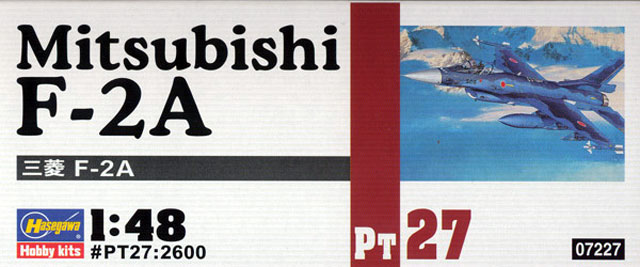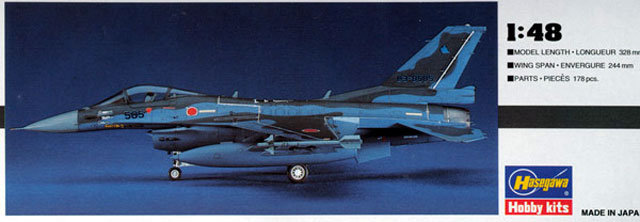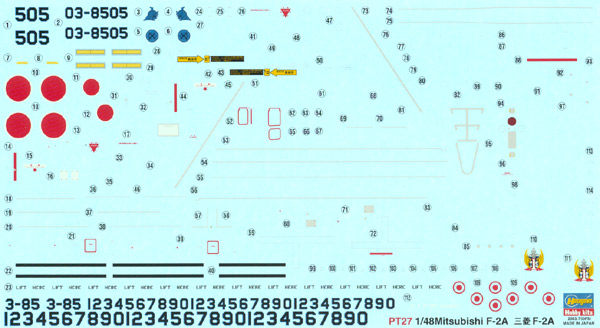|
Mitsubishi F-2A

Hasegawa
S
u m m a r y
|
| Catalogue Number
and Description: |
PT27 / 07227 |
| Scale: |
1/48 |
| Price: |
2600 Yen (Japan) |
| Contents and Media |
Injection molded plastic and resin
conversion parts |
| Review Type: |
FirstLook |
| Advantages: |
Good detail. Separate flaps. Full
intake trunking. |
| Disadvantages: |
Seam on radome might be a problem.
Ejector pin marks inside intake duct. |
| Recommendation: |
Recommended |

HyperScale is proudly sponsored bySquadron
Reviewed by Dave
Williams
Developed in co-operation with Lockheed-Martin, the Mitsubishi F-2 is a
tactical support fighter designed to replace Japan’s F-1 and F-4EJ kai fighters
in the attack role. Although the aircraft was developed from, and has the
general appearance of an F-16, looks are deceiving. The F-2A has a new composite
wing that is greater in span and has an area 25% larger than the standard F-16
wing. Each wing has four underwing hardpoints, in addition to a wingtip missile
rail, giving a total of 10 wing stores stations, plus a 11th pylon under the
belly. The fuselage is also slightly lengthened to increase internal fuel and
avionics bay size. Along with the new wing and fuselage, the horizontal
stabilizers are also bigger, being 20% larger than the F-16’s stabs. The
vertical tail is similar to the F-16C’s, although the base is extended at the
rear to incorporate a drag chute housing. Finally, the canopy is new in that it
incorporates a fixed front section for increased birdstrike resistance. In
summary, the F-2 is to the F-16 what the F-18E is to the F/A-18C; a member of
the same family, but sharing few parts with its predecessor.

As is befitting the differences, Hasegawa’s 1/48 F-2A kit is a completely new
tool kit that shares no parts whatsoever with their previous F-16 kits. However,
those familiar with Hasegawa’s F-16 kit will notice a very similar parts
breakdown in this kit. The fuselage halves are split horizontally as is the norm
for almost every F-16 kit. One oddity is that the radome is also split and is
molded with the individual fuselage halves. This leaves a seam that is very near
to the raised rib detail on the radome and care must be taken to avoid losing
the detail when filling the seam. The wings break down similar to the Hasegawa
F-16s with the outboard underside of the wing being molded with the top half of
the wing. The leading and trailing edge flaps are separate parts that allow them
to be positioned as desired. Fortunately, the one-piece flaps are designed so
that they are free of ejector pin marks. The stabilizers are one piece parts
that press into polycaps inside the fuselage. Unlike the F-16 kits, the
airbrakes have no provision for bring displayed in the open position. Photos of
parked F-2s show them with the leading edge flaps in the up position, trailing
edge flaps in the down position, and the stabs at in a 45 degree leading edge
high angle, so the separate parts are a big plus. Overall exterior detail is
good and what we have come to expect from Hasegawa in recent times, although
there is a small amount of flash present in areas like the trailing edge of the
left wing, which is a little surprising in a new kit. It should be mentioned
that the fuselage in this kit is set up to only build the single seat-F-2A.
Undoubtedly, Hasegawa will release the two-seat F-2B as a separate kit with a
new upper fuselage and other specific parts.
Click the thumbnails below to view
larger images:
The cockpit looks good and the F-2’s unique instrument panel is well done.
There is no optional decal for the panel this time around so one must paint the
details. Items like the sidestick, throttle, and some bits for the area under
the rear part of the canopy are provided as separate parts to add to the overall
detail of the cockpit. The ACES II ejection seat is composed of five pieces and
includes the canopy breakers on the headrest, although you’ll have to come up
with straps and belts on your own.
Moving to the underside, the main gear well is molded as a separate piece
instead of being molded to the fuselage. A number of fittings and boxes are
added to detail the well. Overall, the main gear well and main gear feature a
large number of parts and are quite detailed. The nose gear well is molded to
the underside of the intake duct, like their previous F-16 kit. Speaking of the
intake, the kit features full ducting back to a part representing the compressor
face. The ducting is broken up into a front and rear half, with each half being
split horizontally. The inside of the duct parts are marred by a number of
ejector pin marks which, combined with the parts breakdown, makes for a bit of a
job in smoothing everything out. The exterior of the intake is made up of four
parts, comprising a lip, top, and two sides. It should be noted that the intake
shape is a little different than the “big mouth” F-16C, even though the F-2A
uses the same GE F110 engine. The engine turbine has nice detail and the exhaust
nozzle is one piece, which avoids the ejector pin marks seen on the inside
surfaces of the multi-part GE exhaust in Hasegawa’s previous F-16C kits.
As noted previously, the F-2 has eleven stores stations numbered 1 and 11 at the
wing tips, 2-5 and 7-10 under the wings, and 6 under the fuselage. Stores
included in the kit comprise two 600-gallon fuel tanks for stations 5 and 7, a
300-gallon tank for station 6 (you actually get two tanks because of duplicated
sprues), and four AAM-3 missiles for stations 1, 2, 10, and 11. Pylons 3, 4, 8,
and 9 are empty; however the kit does provide the rails used for AIM-7s. You are
on your own in finding the weaponry to add to the four empty pylons, although
Hasegawa does helpfully provide a stores loadout table in the instructions.
Possible stores listed include AIM-7 and AAM-4 medium range air-to-air missiles,
ASM-1 and ASM-2 anti-ship missiles, Mk 82 and JM177 bombs (usually with the
GCS-1 IR guidance kit), CBU-87, and JLAU-3/A or RL-4 rocket pods. Unfortunately,
only a few of these weapons are available as aftermarket items. Hopefully,
Hasegawa will see fit to scale up their 1/72 scale JASDF weapons set to allow
the modeler to arm this kit with some of the more interesting modern Japanese
weaponry.
The kit contains a number of clear parts, including the navigation lights on the
intake sides and lights on the wingtip missile rails. The canopy is made up of
separate parts and can be displayed in the open position, if desired. Hasegawa
has thoughtfully put the clear parts in a separate bag and molded large raised
flanges on the clear sprue to protect the canopy parts from being damaged by the
other parts in the kit. In spite of the precautions however, the windscreen of
the canopy in my kit had a pretty good scrape on the glass portion. One item to
note is that all the canopy sprue attachments are on the frame section of the
clear parts, instead of on the “glass” area. Although my photo seems to show the
sprue attachment on the side of the windscreen, it is only positioned that way
for the picture as the part broke off while removing it from the bag. Finally,
the movable center section of the canopy has the obligatory raised mold line
running down the top that is a necessary consequence of molding the part in the
correct shape.

The decals are standard Hasegawa decals, nice but a little on the thick side.
Specific decals are provided for 03-8505 from the 3rd SQ 3rd AW based at Misawa,
and a scrap view is provided for 03-8504 from the 1st Technical School at
Hamamatsu, both in the production two-tone blue camouflage. Generic numbers are
provided for making 03-8504, or any other 8500 series production F-2A.
Overall, this is a very nice kit for those looking for something
a little different from the standard run-of-the-mill F-16.
Recommended.
Sample kit courtesy of my ever dwindling bank account.
Dave Williams
IPMS/USA 19050
Review Copyright © 2003 by Dave
Williams
Page Created 26 August, 2003
Last updated 12 August, 2004
Back to HyperScale
Main Page
Back to Reviews
Page
|
Home | What's
New | Features
| Gallery |
Reviews | Reference
| Forum
| Search